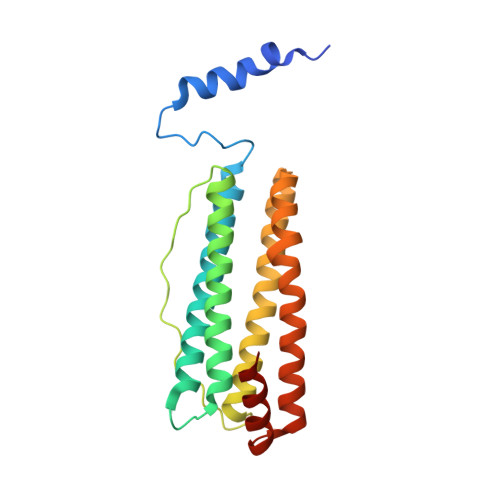The extension peptide of plant ferritin from sea lettuce contributes to shell stability and surface hydrophobicity.
Masuda, T., Morimoto, S.I., Mikami, B., Toyohara, H.(2012) Protein Sci 21: 786-796
- PubMed: 22419613
- DOI: https://doi.org/10.1002/pro.2061
- Primary Citation of Related Structures:
3VNX - PubMed Abstract:
Plant ferritins have some unique structural and functional features. Most of these features can be related to the plant-specific "extension peptide" (EP), which exists in the N-terminus of the mature region of a plant ferritin. Recent crystallographic analysis of a plant ferritin revealed the structure of the EP, however, two points remain unclear: (i) whether the structures of well-conserved EP of plant ferritins are common in all plants, and (ii) whether the EP truly contributes to the shell stability of the plant ferritin oligomer. To clarify these matters, we have cloned a green-plant-type ferritin cDNA from a green alga, Ulva pertusa, and investigated its crystal structure. Ulva pertusa ferritin (UpFER) has a plant-ferritin-specific extension peptide composed of 28 amino acid residues. In the crystal structure of UpFER, the EP lay on and interacted with the neighboring threefold symmetry-related subunit. The amino acid residues involved in the interaction were very highly conserved among plant ferritins. The EPs masked the hydrophobic pockets on the ferritin shell surface by lying on them, and this made the ferritin oligomer more hydrophilic. Furthermore, differential scanning calorimetric analysis of the native and its EP-deletion mutant suggested that the EP contributed to the thermal stability of the plant ferritin shell. Thus, the shell stability and surface hydrophobicity of plant ferritin were controlled by the presence or absence of the plant-ferritin-specific EP. This regulation can account for those processes such as shell stability, degradation, and association of plant ferritin, which are significantly related to iron utilization in plants.
Organizational Affiliation:
Laboratory of Food Quality Design and Development, Division of Agronomy and Horticultural Science, Graduate School of Agriculture, Kyoto University, Uji, Kyoto, Japan. masutaro@kais.kyoto-u.ac.jp















